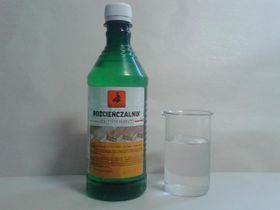Difference between revisions of "Isobutanol"
| Line 66: | Line 66: | ||
| pKb = | | pKb = | ||
| Solubility = 8.7 mL/100 ml | | Solubility = 8.7 mL/100 ml | ||
| − | | SolubleOther = Miscible with [[ethanol]] | + | | SolubleOther = Miscible with [[acetone]], [[chloroform]], [[ethanol]], [[isopropanol]], [[heptane]], [[hexane]], [[methanol]],[[toluene]], [[xylene]] |
| Solvent = | | Solvent = | ||
| VaporPressure = 9 mmHg (at 20 °C) | | VaporPressure = 9 mmHg (at 20 °C) | ||
Revision as of 14:44, 4 June 2019
 Isobutanol extracted from OTC parquet glue.
| |
| Names | |
|---|---|
| IUPAC name
2-methylpropan-1-ol
| |
| Other names
2-methyl-1-propanol
2-methylpropyl alcohol isobutyl alcohol IBA isopropylcarbinol | |
| Identifiers | |
| Jmol-3D images | Image |
| |
| Properties | |
| C4H10O | |
| Molar mass | 74.122 g/mol |
| Appearance | Colorless viscous liquid |
| Odor | Sweet, penetrating |
| Density | 0.802 g/cm3 (at 20°C) |
| Melting point | −108 °C (−162 °F; 165 K) |
| 8.7 mL/100 ml | |
| Solubility | Miscible with acetone, chloroform, ethanol, isopropanol, heptane, hexane, methanol,toluene, xylene |
| Vapor pressure | 9 mmHg (at 20 °C) |
| Hazards | |
| Safety data sheet | ScienceLab |
| Flash point | 28 °C |
| Lethal dose or concentration (LD, LC): | |
| LD50 (Median dose)
|
3.350 mg/kg (rat, oral) 2.460 mg/kg (rabbit, dermal) 720 mg/kg (rat, IP) |
| Related compounds | |
| Related compounds
|
Butanol sec-Butanol tert-Butanol |
| Except where otherwise noted, data are given for materials in their standard state (at 25 °C [77 °F], 100 kPa). | |
| Infobox references | |
Isobutanol, also known as 2-methylpropan-1-ol or 2-methyl-1-propanol is an organic chemical compound, with many uses in industry and chemistry. It is an isomer of butanol and has the formula (CH3)2(CH)CH2OH.
Contents
[hide]Properties
Chemical
Isobutanol will burn in open air, but due to its high flash point of 28 °C, it will only ignite at standard conditions if heated prior.
Physical
Isobutanol is a colorless viscous liquid, with a strong characteristic odor. It is poorly soluble in water (8.7 mL/100 mL), but miscible with many organic solvents such as acetone or ethanol. It has a boiling point of 107.89 °C and a melting point of −108 °C.
Availability
Isobutanol is available at hardware stores as wood paint drying accelerator (acid-curing parquet lacquer/varnish) or as parquet adhesive. The former generally contains HCl, which require neutralization, while the latter does not, but both may have various additives in their composition, so distillation is required to obtain a pure compound.
Preparation
Isobutanol is much cheaper to buy that synthesize.
Projects
- Make isobutyl acetate
- Make p-xylene[1]
- Car fuel
Handling
Safety
Isobutanol is the least toxic isomer of butanol. Its strong odor however may cause nausea or dizziness.
Storage
Should be stored in closed bottles away from any heat source.
Disposal
Isobutanol can be safely burned, though due to its high flash point, it should be mixed with a more flammable solvent and then burned. Do this outside.
References
Relevant Sciencemadness threads
No threads so far. Why not start one?
- Chemical pages without CAS Registry Number
- Articles without EBI source
- Chemical pages without ChemSpiderID
- Chemical pages without DrugBank identifier
- Articles without KEGG source
- Articles without InChI source
- Articles without UNII source
- Articles containing unverified chemical infoboxes
- Chemical compounds
- Organic compounds
- Alcohols
- Primary alcohols
- Solvents
- Polar solvents
- Protic solvents
- Readily available chemicals